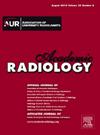Progress and Impact of a Radiology Residency Research Track over 12 Years
IF 3.8
2区 医学
Q1 RADIOLOGY, NUCLEAR MEDICINE & MEDICAL IMAGING
引用次数: 0
Abstract
Rationale and Objectives
Radiology is a dynamic and ever-evolving field, necessitating research and innovation. However, the conventional medical training model falls short in fostering research skills, crucial for cultivating the upcoming cohort of physician-scientists. Our radiology residency research track (RT) was instituted to offer a dedicated research pathway, to foster the next generation of research-focused academic radiologists. The track provides an integrated 4-year longitudinal curriculum and academic time. This study assessed the impact and progress of our RT over 12 years.
Materials and Materials
Using publicly available online data from Doximity, PubMed, and Scopus we collected information on all graduates from our Diagnostic and Interventional Radiology residency program graduation classes between 2010 and 2022, including most recent job position, position type (academic vs. private), and publications. We compared RT and non-research track (NRT) residents.
Results
Out of 185 graduates, 179 profiles (97%) were retrievable, including all 13 RT residents. The average number of publications per resident during residency was 1.1 (186 total) for NRT graduates and 7.2 (93 total) for RT graduates (p < 0.001). Throughout their entire careers to date, NRT graduates averaged 7.3 publications per resident (1249 total), while RT graduates averaged 31.7 publications per resident (412 total) (p < 0.001). The average number of citations per graduate was 123 (21212 total) for NRT and 552 (7175 total) for RT (p < 0.001). Additionally, 36% of NRT graduates and 92% of RT graduates (p = 0.005) held academic job positions.
Conclusion
Residents from the radiology residency research track were more likely to assume academic positions and had a higher number of publications and citations per resident compared to their non-research track counterparts, suggesting the track serves as an effective pipeline for cultivating academic radiologists.
放射科住院医师研究方向 12 年来的进展和影响
基本原理和目的放射学是一个充满活力和不断发展的领域,需要研究和创新。然而,传统的医学培训模式在培养研究技能方面存在不足,而研究技能对于培养即将到来的医师科学家群体至关重要。我们的放射科住院医师研究轨道(RT)的设立是为了提供一个专门的研究途径,以培养下一代以研究为中心的学术放射科医生。该课程提供综合的4年纵向课程和学术时间。本研究评估了我们的放疗在12年内的影响和进展。材料和材料使用来自docximity, PubMed和Scopus的公开在线数据,我们收集了2010年至2022年诊断和介入放射学住院医师项目毕业班所有毕业生的信息,包括最近的工作职位,职位类型(学术与私人)和出版物。我们比较了RT和非研究轨道(NRT)居民。结果185名毕业生中,179份(97%)资料可检索,其中13名住院医师全部可检索。每位住院医师在住院期间的平均出版物数量,NRT毕业生为1.1(共186篇),RT毕业生为7.2(共93篇)(p <;0.001)。在他们的整个职业生涯中,NRT毕业生平均每人发表7.3篇文章(共1249篇),而RT毕业生平均每人发表31.7篇文章(共412篇)(p <;0.001)。NRT的毕业生平均被引用123次(共21212次),RT的毕业生平均被引用552次(共7175次)。0.001)。此外,36%的NRT毕业生和92%的RT毕业生(p = 0.005)担任学术职位。结论与非研究方向的住院医师相比,来自放射科住院医师研究方向的住院医师更有可能担任学术职位,发表的论文和引用的论文数量也更高,表明该方向是培养学术放射科医师的有效途径。
本文章由计算机程序翻译,如有差异,请以英文原文为准。
求助全文
约1分钟内获得全文
求助全文
来源期刊

Academic Radiology
医学-核医学
CiteScore
7.60
自引率
10.40%
发文量
432
审稿时长
18 days
期刊介绍:
Academic Radiology publishes original reports of clinical and laboratory investigations in diagnostic imaging, the diagnostic use of radioactive isotopes, computed tomography, positron emission tomography, magnetic resonance imaging, ultrasound, digital subtraction angiography, image-guided interventions and related techniques. It also includes brief technical reports describing original observations, techniques, and instrumental developments; state-of-the-art reports on clinical issues, new technology and other topics of current medical importance; meta-analyses; scientific studies and opinions on radiologic education; and letters to the Editor.
 求助内容:
求助内容: 应助结果提醒方式:
应助结果提醒方式:


